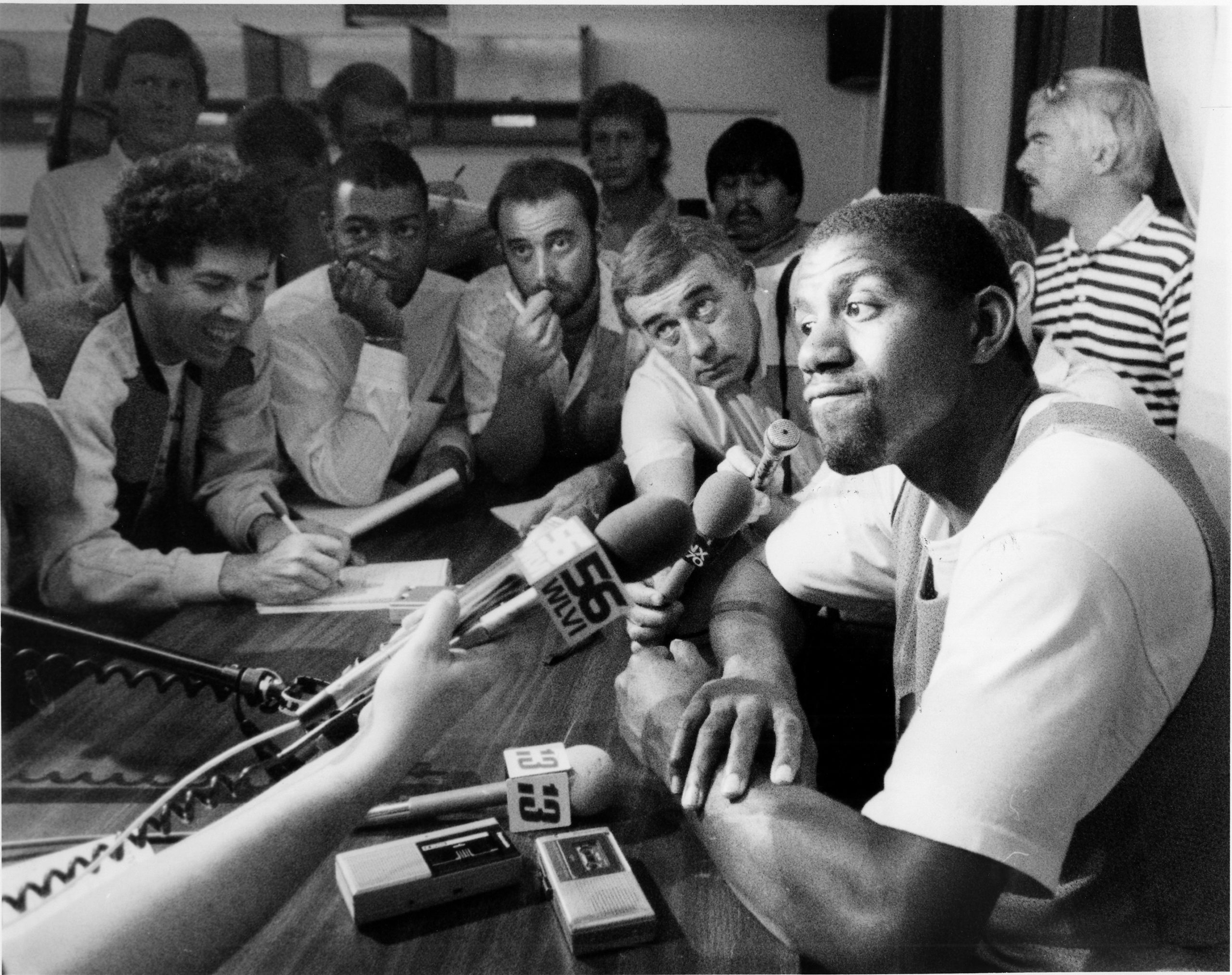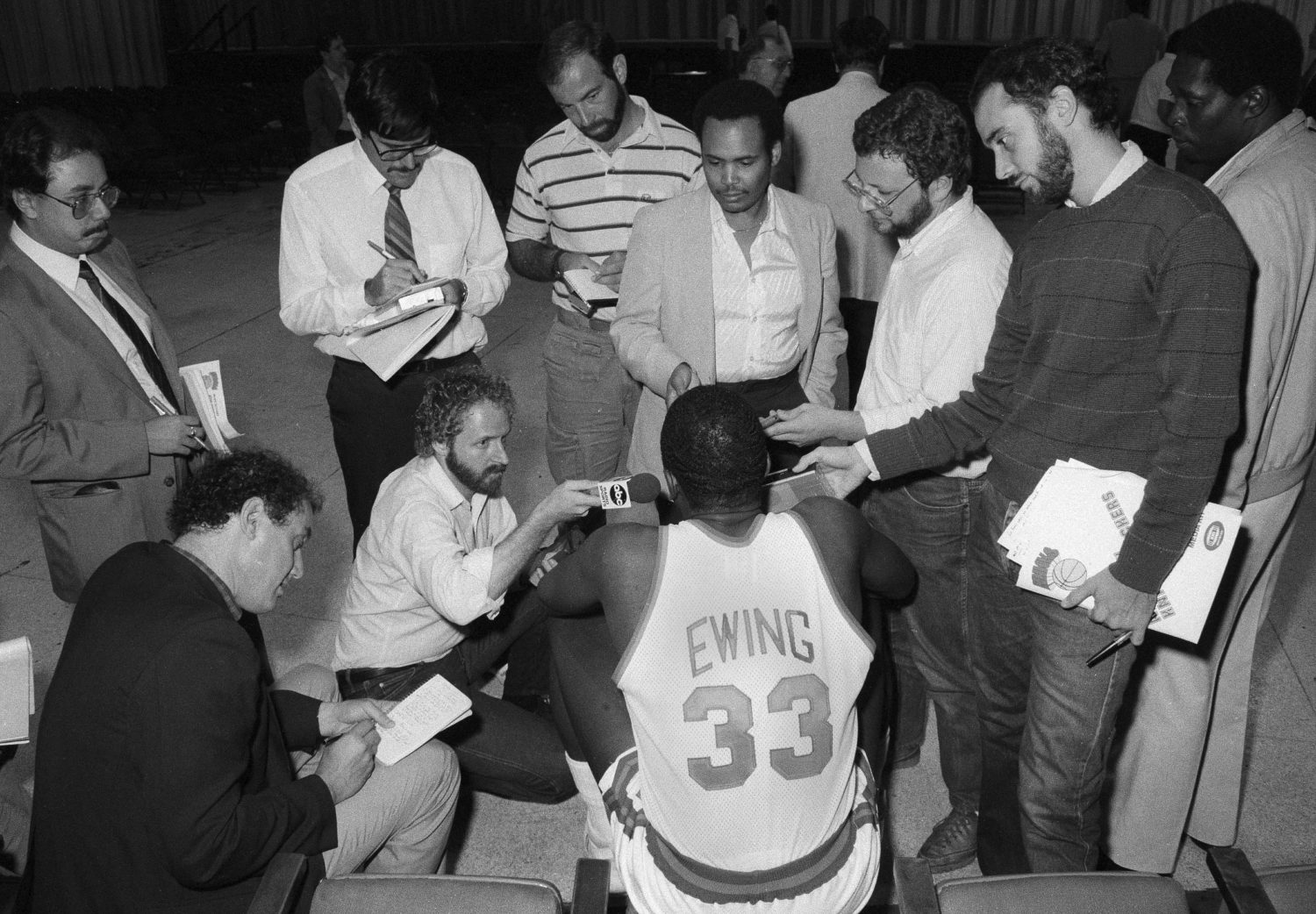Decades before social media allowed players to control the narrative, the National Basketball Association relied on the press to spread the word of an emerging league and its talented players.
In this excerpt from “From Hang Time to Prime Time: Business, Entertainment, and the Birth of the Modern-day NBA” (Atria Books, $27), author Pete Croatto, whose work has appeared in Poynter, The New York Times, SLAM, GQ.com and Shondaland, details why the 1980s were a golden age for the NBA’s press corps.
The beat reporters had once considered the NBA All-Star Game an ideal time to score interviews with stars outside of their coverage area, work on features, and build relationships with sources.
Roy S. Johnson, who covered the NBA for The New York Times, met Julius Erving on a bus ride to practice. Jackie MacMullan of The Boston Globe could approach Charles Barkley in the locker room and grab 15 uninterrupted minutes with the unfiltered Sir Charles.
The years passed. The players’ entourages swelled. The international press came out in droves for the spectacle. A Steph Curry press conference resembled the floor of the New York Stock Exchange. MacMullan, who became a Hall of Fame basketball writer and a high-profile talent at ESPN, was one voice in a wall of sound — “What’s your favorite band?” “What’s your favorite color?” — trying to get Kevin Love to talk about mental health. (When she bellowed if Love had ever seen a mental health counselor, everyone’s head turned.)
“The whole All-Star Weekend was almost like a complete waste,” Jack McCallum of Sports Illustrated said. “The way we had to do our job, which was to get somebody alone, try to get some time with them. That kind of a thing never really worked.”
If there was one benefit to being an NBA reporter in the league’s dark ages, thought Harvey Araton, who did just that in New York for the Post and the Daily News, it was the access. You could work a locker room.
“The attitude of the players in baseball was still like, ‘Hey, we’re doing God’s work here,’” he said. “There was much more of a ‘Hey, son, have you ever played the game?’ mentality. Basketball had none of that. There was a sense that the players intuitively understood that there was a lot of selling to do: the access, the cooperation, and the willingness of the players to really open themselves up.”
Fred Mitchell of the Chicago Tribune could grab members of the Boston Celtics as they walked out of the gym and onto the bus. Robert Parish and Larry Bird talked for as long as you wanted and were comfortable doing so. Araton not only used to stay in the same hotel as the Knicks when the team traveled; he received a list of the players’ room numbers with his hotel key. He joined them on the plane and the team bus, where he had no place to hide from the target of that day’s story.
[the_ad id=”667826″]
Traveling with the players, Ron Thomas, then with the San Francisco Chronicle, believed, led to better reporting. Over a Danish and orange juice at the airport, away from the sweat and din of the locker room, he had a more intimate opportunity to ask questions. It also allowed him to see how the players interacted with one another.
The NBA beat did not hold the same cachet as covering baseball or the NFL, but journalists, including women, encountered an almost unheard-of freedom.
“It was just a much more open, relaxed, friendlier, media-friendly environment,” said MacMullan. “I hated covering baseball. I dreaded it in the ’80s. They didn’t want me in there; I didn’t want to be in there. There was no support for me among the MLB. In the NBA, if anybody messed with me, (then-NBA commissioner) David Stern would know about it in an hour and they’d be held accountable.”
The older, white writers gravitated toward baseball, NFL, and prime-time college ball, Thomas said. Many young African American sportswriters like himself counted the NBA as their first pro beat. The league’s media contacts — Alex Sachare, Brian McIntyre, and Terry Lyons — could not have been more welcoming, he said. The openness extended to the teams. Thomas could cover practices and interview whomever. Practices became his classroom. Thomas spent time with veteran coach Jack McMahon, a wonderful storyteller who shared his observations on the players.
“You just learned to understand things,” Thomas said.
That included the curious case of Purdue’s Russell Cross, whom the Warriors selected with the sixth pick in the 1983 draft. He quickly fizzled. Cross was a strapping 6 feet and 10 inches and 215 pounds, but Magic Johnson was badly outrebounding him. Thomas was puzzled, until a coach explained it to the sportswriter: Cross had short arms. A shorter guy with unusually long arms — like the six-foot-nine-inch Johnson — is a more effective rebounder because he has an additional 2 to 3 inches in height.
“You needed to be sitting with a scout or an assistant coach to understand that stuff,” Thomas said. “I think it helped me write better stories.

The Los Angeles Lakers’ Magic Johnson pauses for moment’s thought during a question and answer period, June 1, 1987 at the Forum in Inglewood, Calif., before the Lakers met the Boston Celtics on Tuesday in game one of the 1987 NBA Championship series. (AP Photo/Lennox McLendon)
Bob Ryan, The Boston Globe’s vaunted NBA writer, said the best time to cover the NBA was during the 1980s. Everyone was accessible. Reporters had pregame and practice access and got to travel with the team. The games were wonderful, and the press wasn’t relegated to rafters but sat close to the court. A reporter could capture the sights and sounds — those crucial, little things that make a story sing.
“The whole experience was at its absolute peak,” Ryan said.
Stern set the tone for a more open relationship with the media. Kevin Sullivan, who handled the Dallas Mavericks’ public relations, remembered Stern, sleeves rolled up, coffee cup in hand, shooting the breeze with the beat writers in the Mavericks’ pressroom before tip-off.
“He was so accessible and affable and had a good sense of humor,” Ryan said. “He seemed to appreciate us and let us feel that we were somebody that should be treated well.”
The NBA press corps loved public relations director Brian McIntyre. McIntyre had worked for the Chicago Bulls, a job he landed after four years of selling Blackhawks and Bulls programs — which he wrote and reported on during his off hours from trade magazine work — outside Chicago Stadium. Years later, McIntyre’s right hand acted up in cold weather, a result of doling out change in frigid winters.
McIntyre excelled at making the media’s job easier, said Alex Sachare, his longtime colleague. Reporters could carry the NBA’s messages and shape the public’s impression, so it was crucial to make key figures, like Stern, available. At the very least, a PR person was always around. Sachare, a former AP basketball writer, knew from experience. It was sometimes hard to get a quote from the league office. Stern understood that a writer from a smaller paper such as The Oregonian would be viewed much more favorably by his editor and her readers if she talked to the commissioner on an issue instead of a spokesperson. So Stern talked.
Baseball writer Steve Wulf, McCallum’s Sports Illustrated colleague, couldn’t believe how accommodating the NBA was when he did a basketball story.
“I can’t believe what it’s like dealing with your league!” he gushed to McCallum, who heard that often from his colleagues. Thomas noticed the difference when he returned to the San Francisco Chronicle to cover the San Francisco 49ers. The football team’s PR people hovered while he interviewed players; it was an uneasy experience.
[the_ad id=”667872″]
Stern had his spats with reporters, but negative coverage did not guarantee exile. In June 1990, a story emerged about Isiah Thomas’s possible involvement in a nationwide gambling operation. (Thomas was later cleared of any wrongdoing.) McCallum didn’t want to cover it; his editors at Sports Illustrated insisted. He spent the weekend with the NBA and Pistons PR trying to get Thomas to talk. He did. McCallum felt Isiah never quite forgave him. Lyons and McIntyre and Matt Dobek, the Pistons’ longtime PR guy, did. The next time, it was business as usual.
“Not to hold a grudge and to continue to be professional — it is huge,” McCallum said. “You start getting this us-against-them mentality when you’re the league and somebody else is a reporter, you’re lost.”
The players knew part of the business was in marketing the league. The writers felt a similar responsibility. Ryan started writing about the NBA for The Boston Globe in 1969. He was a 23-year-old college basketball aficionado, but immediately knew the NBA was a far superior product.
“I kind of made it a mission to preach the gospel about how good this was,” he said. Ryan took that approach into the 1980s.
Harvey Araton felt the players and writers were in it together. “We all loved the game,” he said. “We wanted to see it do well. We were kind of the renegade, upstart league. I think a lot of writers took pride in that.”
As a tide of wonderful players entered the league — highlighted by the triumvirate of Bird, Johnson and Michael Jordan — McCallum had a press pass to the league’s renaissance. The secret was finally out.
He noticed the change at Sports Illustrated, the unofficial sports publication of record, the magazine of Frank Deford and Dan Jenkins that treated sportswriting as stylish, rigorous journalism. The editors passed over pro basketball — unless a scandal surfaced — in favor of football and baseball.
Now, McCallum said, the editors conceded that Bird, Johnson and Jordan were the new heroes worthy of the Sports Illustrated cover, a great honor before the Internet destroyed the impact of a great weekly magazine.
“It would be hard not to have felt that, because that’s when it was new and fresh,” McCallum said. “Not just anecdotally, but provably, that’s when the league found its footing and started to zoom into the stratosphere. That’s just a fact. To be covering the league then was very exciting and very rewarding: nobody would know my name if I didn’t cover those guys.”
McCallum felt he was lifted along with them. He was not alone.
[the_ad id=”667878″]







